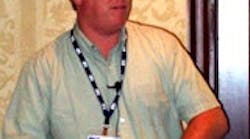Fieldbuses wont take you to the Promised Landjust to an improved network and better control applications. Oh, but the ride may be a little bumpy.
Beyond the required hardware and software updates, perhaps the most important shift is the psychological change that developers and operators must make when implementing digital bus networks.
These are some of the lessons that engineers at Advanced Elastomer Systems learned when they recently replaced and expanded their Florida-based facilitys industrial network. Dave DeBari, Advanceds senior process engineer, reported on these experiences in his Bus or Space Ship? presentation this week at the Emerson Global Users Exchange 2007 at the Gaylord Texan Resort and Convention Center in Grapevine, Texas, near Dallas.
A division of ExxonMobil Chemical, Advanced had been using hardwired, point-to-point, often 4-20 mA instrumentation to help produce thermoplastic elastomer (TPE) pellets for many plastic parts and products manufacturers. These highly engineered pellets have many of the sought-after characteristics of rubber, but they can be made using plastic-production methods and can be used in injection, blow molding and extrusion operations.
Ive really gone from having overloaded three-foot cable trays to having a whole networking world that I can hold in one hand. David DeBari of Advanced Elastomer Systems shared lessons learned from his companys implementation of Foundation and other digital buses.
Ive really gone from having overloaded three-foot cable trays to having a whole networking world that I can hold in one hand, said DeBari. At first, the reasons for going to a digital bus might seem to be that we were crazy or that our egos were too big for our brains, but we really needed a step change in the network for our process. I think in the future, well be going wireless, and then well have no tray at all.
Because of the initial difficulties in implementing a digital bus, however, DeBari added that project organizers and their management must go beyond being simply involved in the network project to being fully committed to it. You know the saying that the chicken is involved in breakfast, but the pig is committed? Well, thats whats needed here, said Debari. You really have to decide if you believe in the power of a digital bus because once youre in, you really cant get out.
To get started on Advanceds digital bus network, DeBari said he and his colleagues found it was essential to plan it thoroughly. Whatever bus protocol is being used, he advises users to ask themselves: Whats the purpose of this network? What do we want it to achieve? What are its benefits?
Next, project organizers must seek and secure their managements agreement, buy-in and commitment. Then they must recruit a design team with genuine field experience.
You cant just have someone whos read a book or magazine, he said. Ive found there are two types of people in these situations. There are real self-starters and go-getters, who are all over what they need to do and can really help you get it done. Then there are the ones who ask you lots of questions and turn around and charge you for the answers you gave them. Only after this initial preparation is done can digital bus developers select the appropriate instruments, he added.
To design a digital bus, DeBari said developers must decide on its naming conventions, topology, data density and distance limits, power requirements, macro cycle considerations, devices, wire and connectors, controller and instrument grouping, and tray requirements. The team also must examine network drawings and loop sheets together to settle on what their digital bus requires and how to set it up correctly.
Because this isnt point-to-point, there are some new issues, said DeBari. One cable may have to pick up five, eight, or 12 new devices, and that cable may have to cross floors. This means looking at location drawings, so the new network can snake through ceiling penetrations or other places.
To aid wiring and setup, DeBari recommends ordering instruments with pre-attached connectors, using factory-made and color-coded drop cables, and buying extra port covers. He also suggests training someone to be the Network Master who can answer installers questions about the digital bus networks distance limits, maximum devices and other specific requirements. He added that Emersons 848T and 752 devices both helped Advanceds network gain the capabilities it needed.
DeBari also explained that network developers must carefully confirm that vendors devices will do what they claim. For example, a powered device cant just provide power for relays, while 24V devices may have difficulties running on a 30V ASi bus. He added that users should tell their suppliers which IP addresses to use on the new networks devices.
Likewise, though EtherNet/IP is a 1,200-piece Erector set that can be used in so many types of networks, DeBari said it can be hard to find assistance to implement a specific network. Theres a lot of propaganda surrounding Ethernet, he said. While many people say they have devices to enable it, anyone who says Ethernet is plug-and-play is just telling a big lie.
A digital bus may cost more initially, but you have to look at the big picture and not just the wire price, DeBari concluded. Once our digital bus was in, we really began seeing operators and maintenance people putting down their tool bags and picking up a mouse to check the network, because the online diagnostics can tell them if their hardware is happy.




